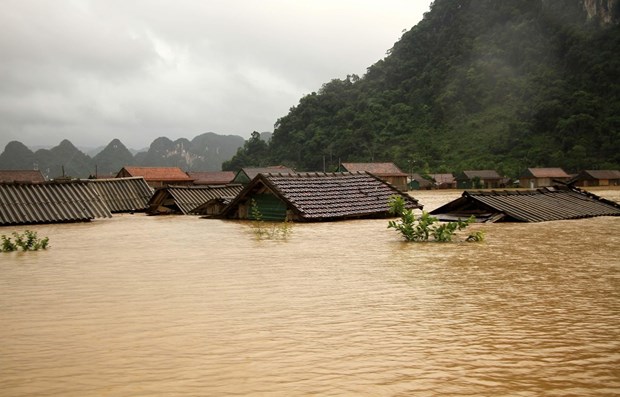 Society
Society


|
| Many houses in Minh Hoá Commune in central Quảng Bình Province were submerged due to flash floods. VNA/VNS Photo |
HÀ NỘI – Việt Nam needs to invest approximately US$368 billion from now until 2040 to build a climate resilient and low-carbon economy, according to the Vietnam Country Climate and Development Report (CCDR) released by the World Bank on Wednesday.
The Vietnam Country Climate and Development Report is one of the first in a series of reports on climate and development of the World Bank Group.
Carolyn Turk, Country Director of the World Bank in Việt Nam, said that Việt Nam is increasingly seeing its development affected by climate change and now faces critical questions about how to respond.
The Vietnam Country Climate and Development Report is about how the country can maintain its economic growth in the time of climate change, and how it can balance its development goals with increasing climate risks, she said.
Climate change costs up to 14.5% of GDP
After more than two decades of steady growth, Việt Nam has set a target of becoming a high income economy by 2045.
To reach this goal, Việt Nam needs to shift its economic model and has initiated actions to cope better with climate change and combat rising greenhouse gas emissions.
With a coastline of 3,260 kilometres that includes major cities and production sites, Việt Nam is among the world’s very vulnerable countries and is highly exposed to sea-level rise, extreme weather and temperature rise.
Initial studies show that the country lost about $10 billion in 2020, equivalent to 3.2 per cent of GDP due to the impact of climate change.
Without appropriate mitigation and adaptation measures, it is estimated that Việt Nam will lose up to 15 per cent of GDP per year by 2050, resulting in one million people falling into poverty again by 2030.
“The country’s rapid economic growth, urbanisation, and industrialisation have been powered by coal-dependent energy creating significant greenhouse gas (GHG) emissions,” she said.
Việt Nam is not a major contributor of greenhouse gas globally, with 0.8 per cent of the world’s emissions. But over the past two decades, the country has emerged as one of the fastest-growing per capita GHG emitters in the world.
Moreover, Việt Nam’s GHG emissions are also associated with the toxic air pollution that plagues many of its cities, especially Hà Nội, with implications for human health and labour productivity.
She said there is a path for Việt Nam to address the climate risks while sustaining robust economic growth - a combination of adapting to climate change by taking decisive measures to protect people, assets, and sectors, and mitigating climate change by steering the economy away from carbon-intensive energy.
If well designed, the country would expand its GDP per capita by more than 5 per cent a year — the average rate needed to become high-income by 2045 while achieving its climate objectives.
According to the report, a series of urgent and impact interventions should be focused on, including a coordinated regional programme for the Mekong Delta, an integrated coastal resilience investment programme for urban centres and connecting infrastructure, a targeted air pollution reduction programme for Hà Nội, accelerated clean energy transition, and a new social contract to protect vulnerable people.
In order to become a climate-resilient and net-zero-emissions economy, the country will allocate additional investments of about 6.8 per cent of GDP annually, or $368 billion cumulatively by 2040.
It recommends the amount can be funded by both the public and private sectors and a combination of domestic and international financial sources.
Adaptation measures will entail significant investments to upgrade and retrofit public assets and infrastructure. Protective investments to manage rising sea levels will also require substantial financing.
To achieve net-zero, Việt Nam will have to make substantial investments in its main emitting sectors, including energy, transport, agriculture, and industry.
Dynamic strategies will be required to curb emissions, especially in the energy sector, where renewables should be promoted, the report revealed. – VNS




